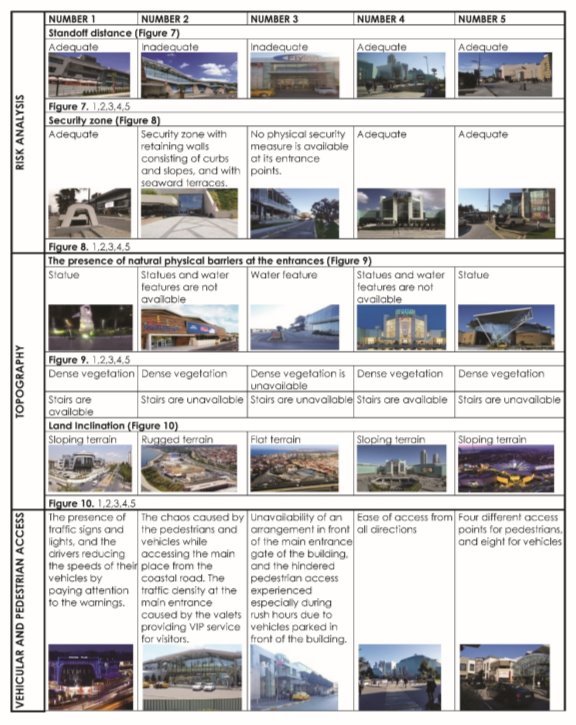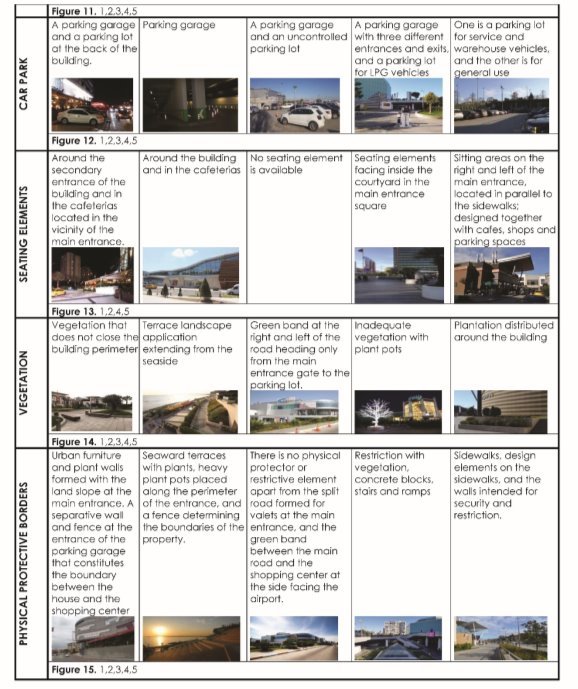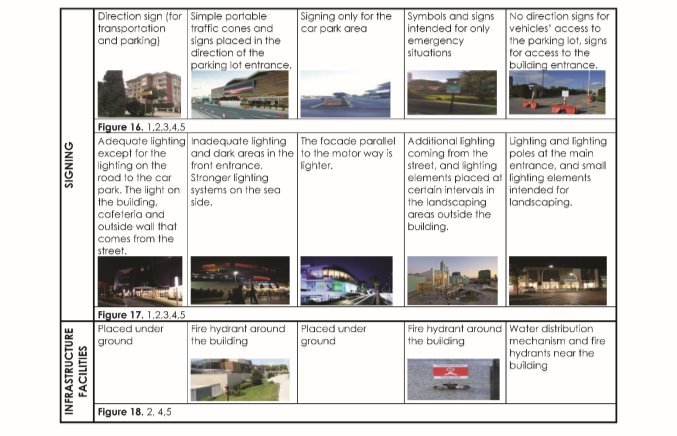How to Cite this Article:
YÜCEL CAYMAZ, G. (2019). The Effects of Built Environment Landscaping on Site Security: Reviews on Selected Shopping Centers in İstanbul. Journal of Contemporary Urban Affairs, 3(1), 191-201. https://doi.org/10.25034/IJCUA.2018.4730
Journal Of Contemporary Urban Affairs
2019, Volume 3, Number 1, pages 191– 201
The Effects of Built Environment Landscaping on Site Security: Reviews on Selected Shopping Centers in İstanbul
* Dr. Gökçen Firdevs Yücel Caymaz
Department of Industrial Product Design, Faculty of Architecture and Design, Istanbul, Turkey
*Corresponding Author:
Faculty of Architecture and Design, Department of Industrial Product Design, İstanbul Aydın University, İstanbul, Turkey
E-mail address: gokcenfyucel@gmail.com
A R T I C L E I N F O:
Article history:
Received 15 July 2018
Accepted 23 September 2018
Available online 28 September 2018
Keywords:
Site Security,
Safety,
Built environment,
Urban Open Space, Shopping Mall
A B S T R A C T

In recent years, the global increase in security concerns made it inevitable to develop new action plans in planning processes. Security concerns come with the necessity of considering building architecture processes together with environmental and landscape design processes. This study aims identification of which measures can be taken into account safely built environment design. It was made a safety checklist which can be adapted for every open spaces. Five shopping malls around the İstanbul were evaluated and some result have been achieved for their site security.
JOURNAL OF CONTEMPORARY URBAN AFFAIRS (2019), 3(1), 191-201. https://doi.org/10.25034/ijcua.2018.4730
www.ijcua.com
Copyright © 2018 Journal Of Contemporary Urban Affairs. All rights reserved.
-
Introduction
The security issue plays an important role in making urban design decisions and determining quality of life criteria. Security is ranked after physiological and biological needs in the hierarchy of vital needs of human beings (Maslow, 1943). Presence of other people makes one feel safer (the concept of “eyes on the street”: the more people, the safer the environment is) (Jacobs, 1961), and people living in the city need safe environments in their daily life cycle. Project for Public Space, and the studies carried out by Lang, Gehl and Turkoglu, which emphasize the importance of safety and trust for the space quality and healthy cities, are important (Lang, 1994; URL 1, Gehl, 2002; URL 2). Positive security perception enhances the urban senses of belonging and ownership. Improvement of social, economic and cultural living conditions besides the improvement of the design conditions of the physical environments influences the perception of positive security (Bal, 2012). Using durable materials such as steel and concrete in urban furniture, expanding the coverage of pedestrian zones, providing dense afforestation, constructing barriers, distributing transfer points of public transportation to multiple locations, and limiting vehicle access to the city center are important actions within the scope of the mentioned action plans (URL 3).
In urban outdoor designing, safe physical planning is important for being able to provide people with psychological comfort. Security planning requires considering the building’s location in the city, its position on the land, its form, landscape design, car park and infrastructure facilities as well as the pedestrian and vehicle access as a whole. In addition to planning studies, security design of the building perimeter also includes the efforts to restrain the sources of unwanted external threats by means of artificial or natural restrictive means such as walls and fences. This kind of security restrictions are intended for keeping potential threat elements away from buildings. Despite all precautions, there may still be a risk of danger due to physical factors as well as budget and personnel restrictions (Hopper and Droge, 2005).
Today, building perimeter security is an issue that concerns all buildings. This study examines the security of shopping centers and their perimeters, as environments with intensive human use that city-dwellers use to carry out their social, cultural and economic activities. According to the definition of the International Council of Shopping Centers (ICSC); “shopping centers are public commercial buildings covering a minimum gross leasable area (GLA) of 5,000 square meters and at least 15 independent departments, which are managed as a single entity. The terrorism threat in commercial shopping centers is an important source of concern due to the fact that 21 countries have had more than 60 terrorist attacks since 1998. According to the analysis results of the statistical data about these attacks, 17 of the terrorist attacks were carried out around and outside the shopping centers; and therefore, security planning is needed for the outdoor spaces of such public buildings (Figure 1) (LaTourrette et al., 2006, URL-2). The same concerns are shared in Turkey as well, regarding the modern shopping center buildings taking the place of traditional shopping centers, the number of which reached 299 in consequence of the increase in their number, experienced especially after the 1980s.
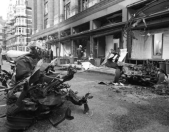
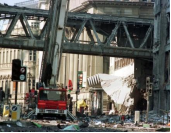
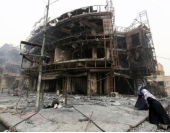
Figure 1. Images of damaged shopping center surroundings: Harrods; Corporation Street: Manchester; Karrada: Bagdad (URL 4)
The result of the investigation made within the scope of this study, on the laws and regulations applicable for building construction processes in our country, showed that no application provision and design criteria for site or urban security has been included in legislations, apart from several laws and regulations such as Construction Zoning Law No.194 enacted in 1985, the Regulation on Occupational Health and Safety in Constructional Works enacted in 2012, the Regulation on Making Spatial Plans enacted in 2014, and the Regulation on Shopping Centers enacted in 2014 (URL 5).
At this point, it is important to define site security of shopping centers besides security of all urban buildings, and establish their legal regulations as well as their planning and design standards. In this study, it is intended to define appropriate site planning principles by establishing standards for site security design.
2. Method Of The Study
In this study, an effort is made to form a checklist intended for measuring the security design processes of building perimeters. The checklist titles were taken by the American Society of Landscape Architects (ASLA) from the “Security Design and Landscape Architecture” titled study of the Landscape Architecture Technical Information Series/LATIS, and the “Risk Management Series” titled study of the Federal Emergency Management Agency/FEMA (LATIS, 2016; FEMA, 2003, 2007). This checklist created basically for building perimeters was applied to five shopping centers in Istanbul. The measurement values of the control list were determined based on the results of a literature review. Afterwards, data were collected for each shopping center by carrying out field studies including on-site monitoring, observations and project analyses. Among the indicators considered to be potentially have an effect on the site security process, those considered to have a positive contribution were scored 1, whereas those considered to have a negative contribution were scored 0 during the formation of the checklist. In consequence of the study, the buildings thought to be relatively well protected were described.
3. Concepts About Building Perimeter Security
In security planning, minimizing the losses of life as much as possible will be the main objective that can be achieved by creating a detailed and integrative security program during the early stages of the site selection and/or design process. Proximity to risky buildings will require additional precautions in site planning. Other issues such as site selection, orientation of buildings, retraction distance, entrance control, activity areas and infrastructure deployment should be considered in the early stage of the design development process. A building structure deployed in a dispersed formation can protect the building from getting damaged completely during an attack. If the elevation of a building is higher than that of the street, it will enhance its security. Proximity to important transportation routes such as railroads, watercourses, highways etc. as well as the existing infrastructure elements such as tunnels should be evaluated because buildings may be subjected to terrorist attacks through these (LATIS, 2016; Russ, 2002, s.320).
Standoff Distance in Risk Analysis
Standoff distance can be defined as the distance between the building and the nearest point, where there may be an unauthorized vehicle access. A longer standoff distance will provide better protection (Figure 2) (National Capital Authority, 2003, p.7).
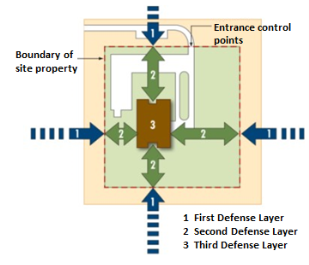
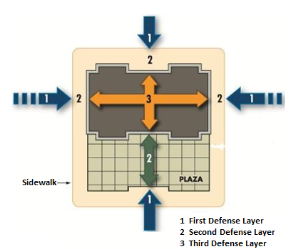
Figure 2. Defense layers; Up: Single building perimeter, Down: Plaza. Perimeter boundary (Site property boundary) determines the security distance around the building that can be uncontrollable for the owner of the building and the people living there (FEMA, 2003)
Security zones in risk analysis
Security zones between the building and streets can be defined as building perimeter, border/pedestrian path, border and parking zones (Figure 3). Measures are usually taken in the building perimeter and the border/pedestrian zones.
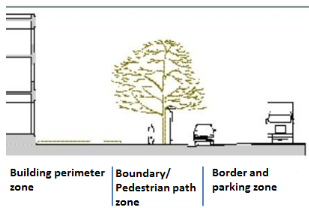
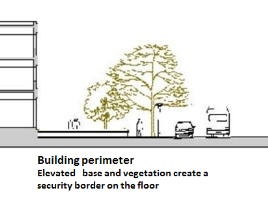
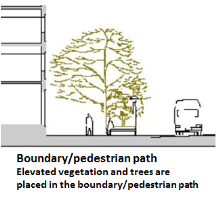
Figure 3. Up: security zones (National Capital Authority, 2003, p.7); middlel: building perimeter zone; down: border/pedestrian zone (National Capital Authority, 2003, p.9).
Security analysis includes the situation assessment of the site perimeter and outside the site. Topography, vegetation, adjacent land uses, fields of vision, storage areas, locations of the infrastructure facilities, existing lighting elements, service vehicles, entrance points for the personnel, and access and circulation system for visitors are the issues important in planning (The American Institute of Architects and Demkin, 2003, p.44).
Topography
The presence of natural physical barriers such as water elements, dense vegetation, and uneven terrain can be helpful for providing access control and consequently for ensuring the security of the site (Figure 4, 5).

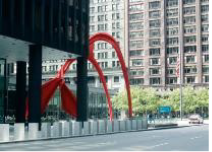
Figure 4. Security protection has been designed in harmony with the architectural identity of the building. The Federal Complex containing the three iconic buildings of Mies van der Rohe and the statue of Alexander Calder (Chicago, Illinois) (Photo General services administration by teng and associates, Chicago) (FEMA, 2007).
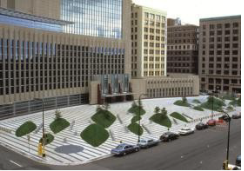
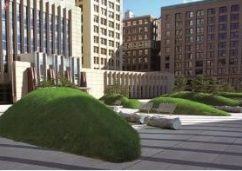
Figure 5. The Minneapolis courthouse plaza. Small lawn hills and logs prevent possible vehicle attacks along the facade of the building (FEMA, 2007)
Vehicle and pedestrian access
The number of vehicle entrance points should be low as much as possible. The size of the adjacent streets and the traffic will determine the vehicle entrance points. Ensuring an adequate retraction distance along the entrance of the building will be effective particularly in controlling the access for vehicles. (LATIS, 2016; FEMA 2003).
Car park
Parking spaces should be away from the building, and should be controllable by the security staff (Russ, 2002, p.321). Underground car parks are highly risky in terms of potential bomb attacks, and they require high security control. Where possible, they should be designed to remain outside the building (LATIS, 2016).
Seating Elements
Open spaces with seating elements should be formed around the building (FEMA, 2007). Benches planned together with plant pots, bollards and other urban furniture can be used in security control in intensively use areas around the building. If the benches will be placed on the sidewalk zone, they should be positioned in such a way as to ensure that they face the street and the building, and if they will be placed in the building zone, they should face the street. The presence of benches can provide control against unwanted activities, by providing opportunities for natural monitoring of the environment (Phifer, 2005; American Planning Association, Steiner, Butler, 2006; Russ, 2002, p.319).
Landscape Design
Land forms, water features, vegetation, inclination differences in floor areas, boundaries, urban furniture series, bollards, benches, flagpoles, and sales units can play a role in limiting the access to the site and controlling the pedestrian and traffic flows. They should be placed in such a way not to hinder emergency vehicle entrances, pedestrian flow and pedestrian access. The use of thorny and sharp-leaved plants (Scarlet Firethorn-Pyracantha, Chandelier, Spanish dagger-Yucca gloriosa, Pampas grass-Cortaderia selloana, etc.) around the building can create a natural barrier (FEMA, 2007).
Physical Protective Borders
Physical protective boundaries can create permanent boundaries around the site, by helping in limiting, directing or blocking the access. In addition to their physical effectiveness, protective boundaries also provide a psychological deterrence against those who plan an unauthorized access attempt. Water elements, changes in the topography, vegetation, and outdoor furniture such as fences, walls, bollards, and fountains can provide protection by creating borders (FEMA, 2003). Crash-proof vehicle barriers prevent vehicle access for pedestrian protection and building security. Walls, berms, plant pots, bollards, heavy elements, reinforced urban furniture and trees, water barriers, fences, and sculptural restrictive elements can prevent vehicles from posing a threat to the building (Figure 7) (FEMA, 2007).
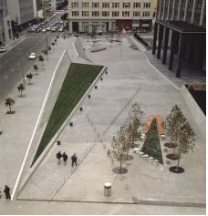
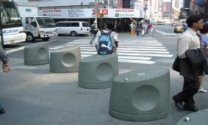
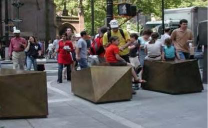
Figure 6. Up: sculptural forms, furniture and bollards serving as restrictive elements. San Francisco Federal Building (FEMA, 2007); middle: Times Square Tower, down: Wall Street, New York City, Rogers Marvel Architects (Phifer, 2005; FEMA, 2007)
Signing
Signing required to be designed correctly and adequately so as to avoid disorders at the transportation, car parks and entrance points should be located outside the site and in the entrances, and should not be used in sensitive areas as unless it is required (FEMA, 2003.)
Lighting
43 lux (= 4horizontal foot-candles) on average will be adequate to provide proper lighting at the entrance control points (FEMA, 2003). Security lighting that enhances natural surveillance for security staff and users is intended to ensure regular lighting in vehicular and pedestrian roads, and to protect people and the building perimeter. Security lighting provides physical and psychological deterrence. Lighting elements with high poles provides a wider and more natural light distribution. They are aesthetically preferred over standard lighting elements (American Planning Association, Steiner, Butler, 2006, p. 275; Hopper, 2007, p.80, Bulla, 2004).
Infrastructure Systems
Infrastructure systems may be significantly damaged after an explosion. Besides constituting physical damages in the building, they may also prevent the evacuation of wounded people. Therefore, the landscape architect should be careful when working on the infrastructure facility. Where possible, substructure facilities such as telephone, electricity, gas and water installations etc. should be placed under ground. The fire safety lines should be well defined, and the water distribution system as well as the fire hydrants should be in a visible place (FEMA, 2007). Care should be taken to abstain from signing critical infrastructure elements as long as it is not necessary. When hazardous materials such as oil, gas and other chemicals are required to be stored, they should be placed downwards on the slope, at least 30.5 m away from the buildings. Garbage cans should be designed to be located 9.14 m meters away from the building, and car parks and vehicle roads should be designed to be at least 15.24 m away from the critical infrastructure systems.
5. Conclusion
A good security design involving technology, operational activities and operational processes is intended for protecting the building against
existing and potential hazards (Hopper, Droge, 2005). In order to ensure an adequate level of protection, precautions should begin to be taken before the construction stage of the building, when taking design decisions related to the building. Particularly the terrain topography should be well analyzed and the zones that will protect the building and the surrounding area should be formed during the site planning process. Ensuring an effective security protection requires arrangements and precautions related to the vehicular and pedestrian roads, car park locations, seating elements, vegetation, restrictions, signing, lighting, and infrastructure facilities. Well-maintained and well-illuminated areas protected by an adequate number of security personnel can play a role in preventing unwanted activities. An effective control can also be ensured through natural surveillance of people around the building. In the evaluation of the checklist created in accordance with these criteria; it was concluded that the site security qualities of the shopping centers 5, 1, 4, and 2 (respectively) were higher than that of the shopping center 3. Although the research results are not definite, they have a nature that can give information about outdoor security, including the subjects of constructional and vegetal landscape design of building perimeters. At this point, this study will have the nature of being a source that paves the way for analyzing the site security qualities of other building perimeters and the existing shopping centers, and for carrying out precautionary and revisionary studies intended for the future.
Acknowledgements
This research did not receive any specific grant from funding agencies in the public, commercial, or not-for-profit sectors.
Conflict of interests
The author declares no conflict of interest.
References
American Planning Association, Steiner, F. R., & Butler, K. (2006). Planning and Urban Design Standards. (pp. 275, 278, 292). Hoboken, New Jersey: Wiley. ISBN: 978-0471760900. https://books.google.com.tr/books?id=3spWR8wdGaQC&printsec=frontcover&dq=Planning+and+Urban+Design+Standards&hl=en&sa=X&ved=0ahUKEwiujNaL0_veAhXq-ioKHcTaCxcQ6AEIMjAB#v=onepage&q=Planning%20and%20Urban%20Design%20Standards&f=false
Bal, İ. (2012). İstanbul Kent Güvenliği [İstanbul City Safety]. Ankara: International Strategic Research Organization (USAK). ISBN: 6054030671. https://books.google.com.tr/books?id=25LHAgAAQBAJ&printsec=frontcover&dq=ISBN:+6054030671&hl=en&sa=X&ved=0ahUKEwjbk8HQ1PveAhWPtYsKHe2GBJEQ6AEIKjAA#v=onepage&q=ISBN%3A%206054030671&f=false
FEMA (Federal Emergency Management Agency) (2003). FEMA 426: Reference Manual to Mitigate Potential Terrorist Attacks Against Buildings (Risk Management Series). DC: Federal Emergency Management Agency. https://books.google.com.tr/books?id=LW0jYM4I7M4C&printsec=frontcover&dq=FEMA+430:+Site+and+Urban+Design+for+Security:+Guidance+Against+Potential+Terrorist+Attacks&hl=en&sa=X&ved=0ahUKEwiPrfaR1fveAhXSo4sKHXcrA9kQ6AEIYDAJ#v=onepage&q&f=false
FEMA (Federal Emergency Management Agency) (2007). FEMA 430: Site and Urban Design for Security: Guidance Against Potential Terrorist Attacks, Providing Protection to People and Buildings. Washington, DC: Federal Emergency Management Agency. https://books.google.com.tr/books?id=Atd4Pg2RXgQC&printsec=frontcover&dq=FEMA+430:+Site+and+Urban+Design+for+Security:+Guidance+Against+Potential+Terrorist+Attacks&hl=en&sa=X&ved=0ahUKEwiPrfaR1fveAhXSo4sKHXcrA9kQ6AEIKjAA#v=onepage&q=FEMA%20430%3A%20Site%20and%20Urban%20Design%20for%20Security%3A%20Guidance%20Against%20Potential%20Terrorist%20Attacks&f=false
Gehl, J. (2002). Public space and public life city of Adelaide: 2002. Adelaide: Adelaide City Council. ISBN: 9781876702670. https://books.google.com.tr/books?id=viYqPQAACAAJ&dq=Public+space+and+public+life+city+of+Adelaide:+2002&hl=en&sa=X&ved=0ahUKEwiayJOh1_veAhVGkywKHe96DxIQ6AEIKjAA
Hopper, L. J., Droge, M. J. (2005). Security and Site Design: A Landscape Architectural Approach to Analysis. Assessment and Design Implementation. New Jersey: Wiley. ISBN: 047165583X, 9780471655831. https://www.wiley.com/en-us/Security+and+Site+Design%3A+A+Landscape+Architectural+Approach+to+Analysis%2C+Assessment+and+Design+Implementation-p-9780471655831
Jacobs, J. (1961). The Death and Life of Great American Cities. New York: Random House. ISBN: 0-679-74195-Xhttps://books.google.com.tr/books?id=7xqruwEACAAJ&dq=The+Death+and+Life+of+Great+American+Cities&hl=en&sa=X&ved=0ahUKEwicgN6_2_veAhVxqIsKHZclAbU4ChDoAQhSMAc
LATIS (Landscape Architecture Techical Information Series), (2016). Landscape Architecture and the Site Security Design Process. http://www.wbdg.org/resources/landscape_sitesecurity.php
Lang, J. (1994). Urban Design: The American Experience. New York: John Wiley & Sons, Inc. ISBN: 0471285420. https://books.google.com.tr/books?id=Rp8ISlY4DBsC&printsec=frontcover&dq=Urban+Design:+The+American+Experience,New+York:+John+Wiley+%26+Sons,+Inc.&hl=en&sa=X&ved=0ahUKEwjmsv3H3fveAhUFtIsKHT2EAIQQ6AEIKjAA#v=onepage&q=Urban%20Design%3A%20The%20American%20Experience%2CNew%20York%3A%20John%20Wiley%20%26%20Sons%2C%20Inc.&f=false
LaTourrette T., Howell D. R., Mosher D.E., MacDonald, J. (2006). Reducing Terrorism Risk at Shopping Centers An Analysis of Potential Security Options. Santa Monica, CA: RAND Corporation. ISBN-13: 9780833040404. https://books.google.com.tr/books?id=N_X4zw0h4g8C&printsec=frontcover&dq=Reducing+Terrorism+Risk+at+Shopping+Centers&hl=en&sa=X&ved=0ahUKEwjr98er3vveAhWxiqYKHcpQBDEQ6AEIKjAA#v=onepage&q=Reducing%20Terrorism%20Risk%20at%20Shopping%20Centers&f=false
Maslow, A. H. (1943). A Theory of Human Motivation, Psychological Review, 50: 370- 396. http://dx.doi.org/10.1037/h0054346
National Capital Authority (2003). Urban Design Guidelines for Perimeter Security in the NationalCapital. National Capital Authority. https://www.nationalcapital.gov.au/downloads/corporate/publications/misc/Urban_Design_G uidelines_LR.pdf
Phifer, J. F. (2005). Perimeter Security for Public Spaces, Implications, Volume 3, Issue 12, University of Minnesota. http://rs.informedesign.org/_news/dec_v03r-p.pdf
Russ, T.H. (2002). Site Planning and Design Handbook. (pp. 319-321). McGraw Hill Professional. ISBN: 978007160559-5. https://books.google.com.tr/books/about/Site_Planning_and_Design_Handbook.html?id=Iq9GxvXcxWAC&redir_esc=y
The American Institute of Architects, Demkin, J.A (2003). Security Planning and Design: A Guide for Architects and Building Design Professionals. (p.44). Publisher: John Wiley & Sons. ISBN: 9780471271567. https://books.google.com.tr/books?id=165NDiCu2X8C&printsec=frontcover&dq=Security+Planning+and+Design:+A+Guide+for+Architects+and+Building+Design+Professionals.+(p.44)&hl=en&sa=X&ved=0ahUKEwiBsvyl5PveAhWBw4sKHZvtARsQ6AEIKjAA#v=onepage&q=Security%20Planning%20and%20Design%3A%20A%20Guide%20for%20Architects%20and%20Building%20Design%20Professionals.%20(p.44)&f=false
URL 1. Retrieved from https://www.pps.org/article/grplacefeat
URL 2. Retrieved from http://www.skb.gov.tr/wp-content/uploads/2011/09/Handan-Turkoglu.pdf
URL 3. Retrieved from http://www.aljazeera.com.tr
URL 4. Deadly terror attack around the world, Retrieved from https://www.express.co.uk/pictures/pics/9102/Terror-attacks-shopping-centre-London-around-the-world-pictures
URL 5.Retrieved from http://www.resmigazete.gov.tr (Offical Gazette of TR)
How to Cite this Article:
YÜCEL CAYMAZ, G. (2019). The Effects of Built Environment Landscaping on Site Security: Reviews on Selected Shopping Centers in İstanbul. Journal of Contemporary Urban Affairs, 3(1), 191-201. https://doi.org/10.25034/IJCUA.2018.4730
This work is licensed under a Creative Commons Attribution - NonCommercial - NoDerivs 4.0.
"CC-BY-NC-ND"
![]()















